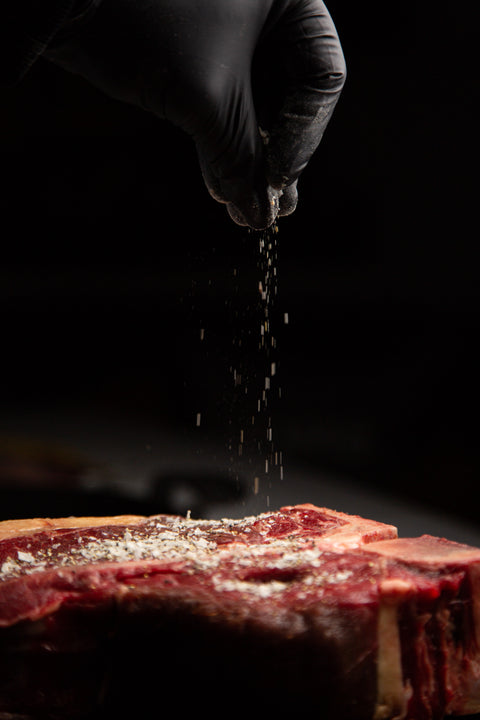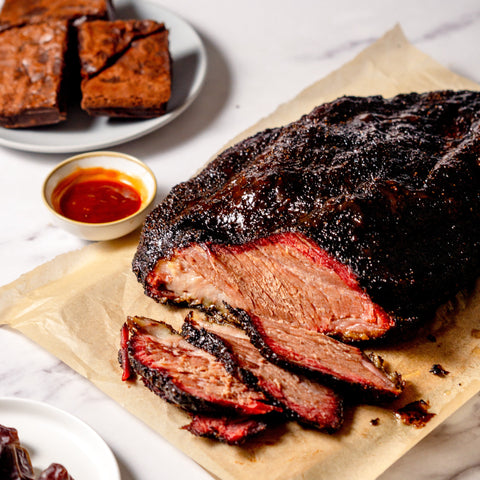Want to achieve restaurant grade steak perfection with that juicy Ribeye or Porterhouse you've just bought?
Mastering the perfect steak is an art form, a culinary adventure that many strive to perfect. One of the many secrets? It lies in a technique known as dry brining. This method, which uses kosher salt (bigger salt flakes) to season steak, not only elevates the flavour but also enhances texture, leading to a tender, juicy steak every time. Unlike traditional wet brines, dry brining steak focuses on moisture retention without the added water, tapping into the science of osmosis and protein denaturing for maximum flavour and tenderness. It’s an essential skill for any steak enthusiast, transforming ordinary cuts into extraordinary meals.
In this guide, we'll delve into the intricacies of how to dry brine steak, from the science behind the process, including the critical maillard reaction and the role of reverse sear, to a practical step-by-step guide. We’ll explore why kosher salt is the salt of choice and how long to dry brine steak for optimal moisture retention. Whether you're seasoning steak for a casual family dinner or aiming to perfect your reverse sear for a gourmet meal, this guide will equip you with the knowledge and techniques to achieve a perfectly dry-brined steak. In this quick guide, we unlock the secret to making your steak more tender, juicy, and flavourful than ever before.
What is Dry Brining?
Dry brining is a culinary technique that has gained popularity for its simplicity and effectiveness in enhancing the flavour and texture of meats, particularly steaks. This method involves salting the meat directly, without the use of water, and allowing it to rest for a period. The process is especially beneficial for steaks, providing deep, flavourful seasoning, tenderising the meat, and aiding in the development of a superior crust during cooking. Unlike traditional wet brines, dry brining doesn't dilute the robust, meaty flavors of steak but instead, focuses on seasoning and tenderizing without adding unnecessary moisture.
The Process Explained
- Preparation: The journey to a perfectly dry-brined steak begins with choosing a good quality steak. A nice thick cut like a Tomahawk or our amazing 'USDA' Brazilian Sirloin steak. Using a kitchen tissue paper, pat dry the steak to remove any surface moisture. The meat is then generously seasoned with salt (kosher salt or course sea salt) on both sides. This choice of salt is crucial, as its larger crystals are key to the process. Use half a teaspoon of Kosher salt per pound of meat (2.8g per 450grams roughly). Top Tip - use a dredger shaker like this to help evenly distribute salt and dry rubs.
- Resting: Once seasoned, the steak is placed on a rack above a foil-lined tray and left uncovered in the refrigerator. This environment, cool and with circulating air, is essential for the dry brining to take effect. It's best to let the steak rest overnight but a minimum of 3hours will do.
- Osmosis and Diffusion: Shortly after salting, osmosis kicks in. This is where water moves from an area of lower solute concentration (inside the steak) to a higher concentration (the salty surface), creating a watery layer that dissolves the salt. Following this, diffusion occurs, where the now dissolved salt moves back into the steak to evenly distribute itself. This dual process not only seasons the meat deeply but also starts the tenderising process by breaking down muscle proteins.
- Drying and Concentrating Flavours: By leaving the steak uncovered on a wire rack in the fridge, the cold air circulates around the steak, accelerating the drying process. This not only helps in forming a better crust when cooking but also enhances and concentrates the natural flavours of the steak, making it taste beefier and more robust.
The Science Behind Tenderising
Salt plays a pivotal role in the tenderising aspect of dry brining. It works to denature proteins in the meat. Essentially, meat proteins are like strings bundled together, and salt loosens these strings slightly from each other. This action results in a more tender bite once the steak is cooked.
Why Dry Brine?
Dry brining is favoured for several reasons:
- Seasoning: It seasons the steak before cooking, slowly enhancing the natural flavours of the beef as the salt penetrates the meat.
- Crust Formation: As the surface of the steak dries out, it's primed for creating a great crust during cooking, while the interior remains juicy and tender.
- Tenderisation: The process naturally permeates the beef, breaking down muscle proteins and locking moisture into the steak, resulting in a tender and juicy meal.
In summary, dry brining is a method that leverages the natural moisture content of the meat to create a concentrated brine. This brine, when absorbed back into the meat, seasons it deeply and prepares it for cooking by tenderising the fibers and ensuring moisture retention. The result is a steak that is not only well-seasoned but also boasts a perfect balance of tenderness and juiciness, all achieved with the simple yet powerful ingredient: salt.
Tips to Avoid Over-Salting
A common concern with dry brining is the risk of over-salting the steak. To avoid this, it's important to use the salt as if seasoning the steak right before grilling, not more. The aim is to enhance the steak's flavour, not overpower it with saltiness. Use half a teaspoon per pound of meat for kosher/course salt. If you do have to use table salt, use a quarter of a teaspoon per pound of meat. For those new to dry brining, starting with a shorter brining period can help gauge the saltiness level. Remember, the steak should not be rinsed after brining, as this would remove the flavours developed during the process. Simply use a kitchen paper towel to dab any excess surface moisture away.
Incorporating these steps and tips into the dry brining process will ensure a steak that's not only flavourful and tender but also beautifully crusted upon cooking. Dry brining is a simple yet effective technique that elevates the humble steak into a culinary delight.
FAQs
How to Properly Dry Brine a Steak
Q: What are the steps to dry brine a steak?
A: To effectively dry brine a steak, follow these steps: First, ensure the steak is completely dry by patting it down with paper towels. Then, season the steak generously with kosher salt or seasoned salt, ensuring it's fully coated using half a teaspoon per pound of meat as a guide. Place the steak on a plate or wire rack and leave it in the refrigerator, uncovered, for anywhere between 3 to 48 hours. Finally, cook the steak using your preferred method.
Q: How much salt should be used when dry brining a steak?
A: To effectively dry brine a steak, use half a teaspoon of kosher or course salt per pound of meat (about 2.8g per 450grams)
Q: What is the best salt to use for dry brining?
A: Use a kosher salt (like this or Diamond kosher salt) or a course sea salt. We want a big salt flake to effectively cover the surface area without making our meat overly salty whcih could happen with using regular table salt.
Understanding the Science Behind Dry Brining
Q: Can you explain the scientific process behind dry brining a steak?
A: Dry brining works through a simple scientific process. When salt is applied to the steak, it draws out moisture, which then dissolves the salt, creating a concentrated brine on the steak's surface. This brine is subsequently reabsorbed into the meat, and as a result, the surface of the meat dries out. This dry surface allows for a much better sear when cooking.
Duration of Dry Brining
Q: What is the recommended duration for dry brining a steak?
A: For best results, a steak should be dry brined for a minimum of 3 hours. However, you can leave the steak to dry brine for up to three days to enhance its flavour and tenderness further.
Guidelines for Dry Brining
Q: What are the essential guidelines for dry brining meat including poultry?
A: When dry brining, especially something like a turkey or chicken, it's crucial to start by patting the turkey dry. Begin the salting process at least one day before cooking, and up to two days in advance (for a large turkey) for optimal results. Ensure the turkey is thoroughly covered in kosher salt (half teaspoon per pound). Then, refrigerate the turkey uncovered and do not rinse it before cooking. Finally, roast or cook the turkey or chicken as desired.



